Sally Cleveland Artist Talk, Saturday, May 5 at Prographica/KDR
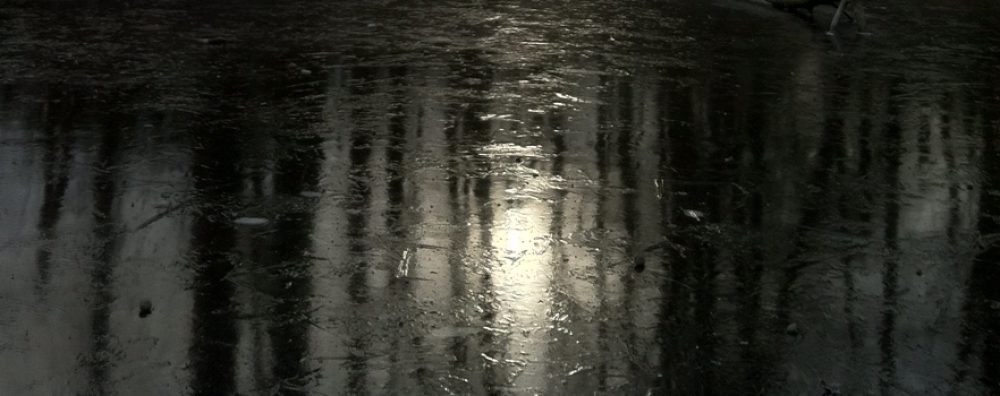
Sally Cleveland Artist Talk, Saturday, May 5 at Prographica/KDR
Things That Kill curated by Norman Lundin
“Consider, for example, such varied assassins as leaded water, pills, red meat, too much sun…. Consider, for a moment more, that of the many things that kill, countless are appealingly beautiful as well as lethal, seducing artist and viewer. How to handle these “killers” in such a way that the intended expressive implications are conveyed, is as formidable an artistic challenge as engaging the more overt content implied by the show’s title.” -Norman Lundin
Including work by: Fred Birchman, Brian Blackham, Marsha Burns, Joe Crookes, John Fadeff, Ellen Garvens, Jim Holl, Michael Howard, Amy Huddleston, Caroline Kapp, Dianne Kornberg, Riva Lehrer, Brian Murphy, Elizabeth Ockwell, Anne Petty, Glenn Rudolph, Graham Shutt, Kathy Vargas and Evelyn Woods
September 1 – October 29, 2016
Opening Reception: First Thursday, September 1, 6 – 8pm
Artist Interview #35 Part 2: Dianne Kornberg
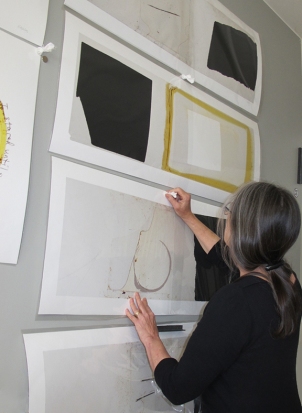
1. In what way is your work a reflection of the theme “Things That Kill”? Is your work for this show in line with or an exception to your usual way of working?
“Madonna Bomb 2” is the second in a series of four pieces that are a response to a poem by Celia Bland. The poem describes a suicide bombing, while referring metaphorically, in the context of the project as a whole, to the “bomb” of childbirth and parenting. It is one of twenty-six images that make up the exhibition and book titled Madonna Comix.
The stylistic elements I employed for this series are unique in my work–I developed them for this particular image/text project.
The subject matter–a pregnant woman wearing a suicide vest, plus the included poetic and comic text, is loaded content, at the very least the shock of a woman surfacing as a militant combatant in a religious cause, a jihad. For me there is an equivalency between the content and the “art” and I believe the art holds its own. But you will decide for yourself if the piece is “front-loaded.”
2. How did you approach the subject matter?
The project began when Celia sent me a selection of poems about the Madonna. I found that they addressed a range of ideas: the physicality of childbearing, self-sacrifice and suffering, ecstasy and adoration. They spoke of fears and choices and of things we take on faith. They spoke to multiple experiences of being a woman.
I considered the “smart-alecky” nature of some of the poetic text. I decided to scan Lulu comic book pages, and partially erase the images to serve as the surface on which to work. The proto-feminist “Little Lulu” comic books were empowering to me as a girl in the 1950’s because Lulu stepped outside gender roles–she went her own way, had opinions, out-witted the boys. I allowed some of the Lulu text to show through to serve as a “down to earth” commentary on Bland’s lyric language. My working process was very experimental. I utilized skills from my background in painting, printmaking, and photography. In addition to the figure, I included in the image the pentimento comic book page, a map of Jerusalem, a selection of text from the poem, and text from Little Lulu.
3. Are there any anecdotal notes that may give insight to a new viewer about your work in “Things that Kill”?
When I began working with the poem “Madonna Bomb” I went on-line to learn about suicide bombers. I came across a picture of a 15 year old girl hand-cuffed to a chain-link fence, wearing a suicide vest. At the time I did not realize that girls were being used as suicide bombers. The Lulu text included in Madonna Bomb 4 reads, “A little girl! WHAT?”
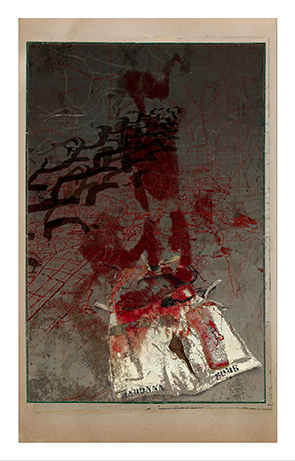
“Madonna Bomb 1”, 2012, archival pigment print
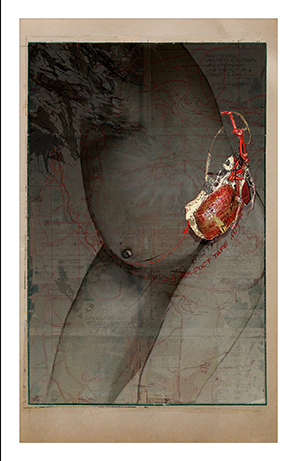
“Madonna Bomb 2″, 2012, archival pigment print, 31″ x 20” image, 32.5 x 21.5” framed (included in “Things That Kill”)
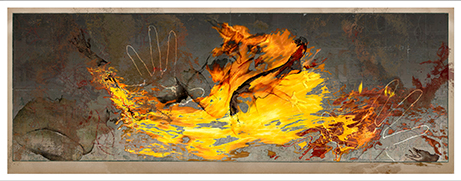
“Madonna Bomb 3”, 2012, archival pigment print
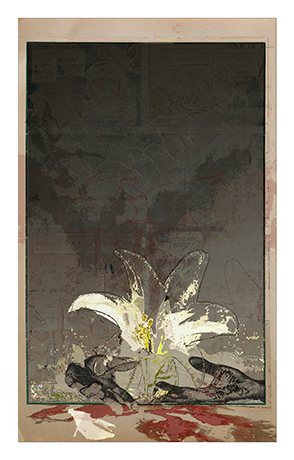
“Madonna Bomb 4”, 2012, archival pigment print
Things That Kill curated by Norman Lundin
Fred Birchman, Brian Blackham, Marsha Burns, Joe Crookes, John Fadeff, Ellen Garvens, Jim Holl, Michael Howard, Amy Huddleston, Caroline Kapp, Dianne Kornberg, Riva Lehrer, Brian Murphy, Elizabeth Ockwell, Anne Petty, Glenn Rudolph, Graham Shutt, Kathy Vargas and Evelyn Woods
September 1 – October 29, 2016
Opening Reception: First Thursday, September 1, 6 – 8pm
Artist Interview #50: Jim Holl
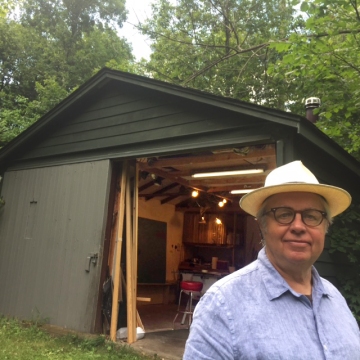
1. Are you a full time artist, if not how do you support your art?
I have supported my art making over the years as a graphic designer. Currently I am the coordinator of the Graphic Design Concentration at Marymount Manhattan College in NYC.
2. When did you consider yourself an artist?
I understood to be an artist could be a career freshman at the University of Washington in an art class taught by Norman Lundin.
3. What are your influences?
In the early 70’s my main influences was the “west coast figurative school,” Diebenkorn et al.
The mid 70’s was the apogee of conceptual art. This influence began with Duchamp.
4. How big is your studio, what kind of lighting?
I have a summer and a winter studio in Catskill, New York and a summer studio in Manchester Washington, and a storage shed to put it all in, all of them small.
My studio lighting is mixed, mainly tungsten.
5. What is a typical day in the studio like for you? Do you listen to music, radio or tv in your studio?
I wish I had more typical days, when I do I spend the mornings in Catskill, sitting in the screened-in porch working on the computer. In the afternoon I am across the field in the studio, and running errands. I dine early and am in bed by nine! In years past when in NYC I spent the day doing commercial design projects at an office in Manhattan and made artwork in my Williamsburg studio until the wee hours of the night. My music of preference is ambient. Reminds me of nature.
6. What is your preferred medium? Do you work on one project at a time or several?
I prefer oil paint on board. I have experimented with many mediums over the years and found it wasn’t the mediums that made my art better. So I settled on a medium that does not call attention to itself.
I work on a few paintings at a time, going back and forth as they call me for attention.
7. What do you do outside the studio, aside from a job?
I go to art shows, dinner with friends, nothing unusual, I work all of the time. Life is short.
8. In what way is your work a reflection of the theme “Things That Kill”? Is your work for this show in line with or an exception to your usual way of working?
I was wondering that myself when Norman asked me to be in the show. I have been working on a theme I call “All the Living Things.” I choose plants as the subject matter for their organic and many times simple forms. The images rendered close up can easily cross into abstraction. I think all paintings are still-lifes, lives that have been stilled. The organic forms I have been exploring enliven the compositions. This and the contrasting colors express a vibratory quality that complements the stillness of the paintings. In addition I prefer the work to express an ambiguity, for uncertainty is innate in nature.
All of this was crossing my mind while having lunch with Norman. Norman replied, “Why not poison plants?” I thought, what a great idea!
With each exhibition, we will post interviews with the participating artists along with a photo of said artists in their studios and images of their work. In the future, we will post videos of artist interviews.
Sky Paintings, a solo show of new work by Philip Govedare opening November 7 and continuing through December 19, 2015.
There will be a conversation with the artist followed by a reception on Saturday November 14 from 2-4 pm.
Artist interview #33: Philip Govedare
1) How is your process different in the studio compared to when you are out in the landscape?
I spend a lot of time in nature doing a variety of things, always looking for my subject matter and observing qualities of light, form etc. I do drawings from observation on site as a way of understanding and internalizing what I am seeing. My paintings are completed entirely in the studio and are a combination of imagination and memory, but also informed by drawing and the time that I spend in the landscape.
2) In a discussion with students about painting clouds, you asked: “You can’t capture it, so how do you capture the essence of what it is?” How have you approached this in your study, not only of clouds, but also of the fleeting nature of light in the landscape?
Light in the landscape is both fugitive and transformative. It is the essence of spirit and vitality, sets a mood, and in my paintings, is created in large part through color relationships. Through an exhaustive process of testing possibilities with moving paint around on canvas with a brush and palette knife, I arrive at a form or quality of light that is “found” rather than reproduced directly from observation. It is an inefficient process of trial and error, but it relies on knowledge and memory, imagination, and to some degree “the happy accident”.
3) What is the importance of observation, memory and imagination in your practice?
Drawing through observation is a process of selection, and a means to simplify and understand an infinitely complex world. What is left out is as important as that which is recorded, and the imagination plays a role in filling in gaps and making it whole. People sometimes ask me where I get my images, or if I copy photographs (I do not). The assumption is that painting is simply a matter of depicting an established or preconceived idea. My images are found through a seemingly endless process of revision and reconfiguration. A painting comes to life when I make a discovery, and encounter a situation that resonates, and is fresh, visually potent, and provocative.
4) You have mentioned: “skies set the emotional tone” would you expand on that thought?
As a species, I think we are biologically programed to respond to different conditions of weather and light. It is part of human evolution to be sensitive to these qualities since climate and weather have implication for basic survival. A brooding winter sky elicits a very different response than a summer sky with benign puffy white clouds. In my work, skies are less about a literal depiction of an observed phenomenon or place, but are a metaphor and a mirror to an interior landscape of individual consciousness. Serenity or tumult, stasis or upheaval, these are expressed through the transformative qualities of light and atmosphere, the suggestion of precipitation, wind and temperature. They embody the full range of the human emotion that includes hope and foreboding, joy and despair, bravado and frailty, and elicit questions of purpose, mortality and the eternal.
5) In your painting, what does it mean for a given work to succeed?
Matisse said that a painting is finished when anything that the artist adds to the painting detracts from it. In a larger sense, for me a painting should be revelatory, and contain a mystery or reveal some hidden truth. It must have a compelling presence that cannot be reduced to a simple formula or explanation. It should feed the imagination, and provoke a sense of wonder by presenting the familiar in a way that is fresh, challenging and somehow exhilarating.
6) How do you understand form in relation to expression?
I think that painting is all about paying attention, noticing things, and becoming sensitized to the world around us. There is the cliché that learning to paint is learning to see, and I have no doubt that I see the world differently as a consequence of painting. How things are constructed through the manner in which paint is handled (edges, brush work and surface quality, opacity and transparency) lends itself to expression. A particular technique adapts to the demand for expression, and finds a way to translate an experience in the most direct, subtle and complex terms. Ultimately, there is no formula for expression. The mystery of painting is that it is a deeply subjective enterprise, intuitive for both the artist and the spectator.
With each exhibition, we will post interviews with the participating artists along with a photo of said artists in their studios and images of their work. In the future, we will post videos of artist interviews.
“Observing Observing (a white cup)” opens September 12th and continues through October 31, 2015
Curated by Eric Elliott, Michael Howard & Norman Lundin. More than twenty artists (both gallery artists and not) accepted the invitation to submit work.
Reception for the artists, Sept. 12, 2 – 4 pm
Artist Interview #19: Kenny Harris
1. How did you respond to the idea of the white cup?
For me the conditions are very important- so I waited till the right conditions were present and I found a cup and painted it in a sitting.
2. Are you a full time artist, if not how do you support your art?
Yes, full time. I teach art as well at Laguna College of Art + Design
3. When did you consider yourself an artist?
I think when I moved to LA from New York with the intent of being an artist- Leaving behind a graphics career.
4. What are your influences?
Old European painting and certain modernist movements- Vermeer + Diebenkorn. Velazquez + Morandi.
5. How big is your studio, what kind of lighting?
My current studio is a bedroom in my house—2 north facing windows plus a large fluorescent fixture to augment the natural light. It works well for studio work, but I like painting from life else where: “in the field”, ie on location wherever!
6. What is a typical day in the studio like for you? Do you listen to music, radio or tv in your studio?
I listen to music and radio a lot. Day usually starts with NPR, then some mid tempo music, then I like a certain type of high energy bass music to keep my brain agile and moving.
7. What is your preferred medium? Do you work on one project at a time or several?
Oil on panel, or oil primed canvas/linen. I work on lots at a time. Many small studies, a few larger works in progress.
8. Do you have any special or unique tools, devices or process that you use in your art making?
Nothing too special—I use a lot of palette knife. I’ll use long handled brushes sometimes. Recently I started doing some portraits on plexiglass.. not sure where that’s going but we’ll see!
9. What do you do outside the studio, aside from a job?
Well, travel is very important, so my wife Judy and I do that a lot—gathering inspiration. I like to play beach volleyball in Venice and Santa Monica, and jump in the ocean when I can!
With each exhibition, we will post interviews with the participating artists along with a photo of said artists in their studios and images of their work. In the future, we will post videos of artist interviews.
“Observing Observing (a white cup)” opens September 12th and continues through October 31, 2015
Curated by Eric Elliott, Michael Howard & Norman Lundin. More than twenty artists (both gallery artists and not) accepted the invitation to submit work.
Reception for the artists, Sept. 12, 2 – 4 pm
Artist Interview #18: Judy Nimtz
1. How did you respond to the idea of the white cup?
I was excited about the challenge. How do I make the white cup personal and interesting to me? At first I had some pretty complex ideas but in the end chose a cup that I wanted to spend time with – my husband’s favorite coffee mug, which has a glaze finish I love. It’s organic and uneven; you can see the terra cotta clay showing through in areas. Painting the mug, mentally caressing it, ‘feeling’ the undulations was similar to painting one of my figures.
2. Are you a full time artist, if not how do you support your art?
I am a full time artist. Over the years I have supplemented my art income with various project-based jobs.
3. When did you consider yourself an artist?
I’ve always considered myself an artist but as an adult wasn’t comfortable saying it to others until my first solo exhibition.
4. What are your influences?
19th century academic artists, Pre-Raphaelites, artists of the Renaissance period, various fantasy artists, books, music, travel, being out in nature – in particular I get inspired by rainy, grey, stormy weather, and large rocks.
5. How big is your studio, what kind of lighting?
My studio is in our garage, approximately 250 sq ft. I prefer natural light and have a diffused skylight, but I also have various spot and fluorescent lights that allow me to paint at night or control the light as needed.
6. What is a typical day in the studio like for you? Do you listen to music, radio or tv in your studio?
I try to get into the studio early, I feel I’m most productive in the mornings and daytime, but I’ll paint anytime really. I typically paint for about 5 hours, and will also work in my office on my computer figuring out compositions and doing Photoshop manipulation. I listen to a combination of NPR, music, and audio books. What I listen to is pretty important, if there is a certain mood I’m trying to convey or that I want to be in while I’m working I’ll make sure I listen to the appropriate music or audio books. I almost never work in silence; my mind wanders too much to things not pertaining to art if I do.
7. What is your preferred medium? Do you work on one project at a time or several?
I primarily work in oils. I’m usually working on more than one painting at a time and also smaller studies in preparation for future paintings. Because of this I make extensive notes on each painting to help me keep track of what I’m doing on the different paintings.
8. Do you have any special or unique tools, devices or process that you use in your art making?
For my figure paintings I work from photo references I’ve taken. I’m not interested in copying the photo and will do a bit of Photoshop manipulation to them before moving on to making the studies. I often paint from a black and white image because I’m more interested in values than the color information in the photos. For about 10 years now I’ve been using a computer monitor for my references instead of printing the image. This allows me to zoom in or out as needed as well as enables me to manipulate an image while I’m painting. I like to think I’m saving a few trees in the process.
9. What do you do outside the studio, aside from a job?
Spend time with my husband, who is also an artist. Physical fitness and health is important to me in general and painting can be fairly physical at times so I try to keep myself strong. Recently I’ve begun swimming laps, and getting in the water a few times a week also helps ease my homesickness a little (I’m from Hawai’i). I love watching movies and discussing them, reading, cooking, having a glass of wine with friends, spending time in the yard. My husband and I travel quite a bit, usually turning each trip into a painting adventure!
With each exhibition, we will post interviews with the participating artists along with a photo of said artists in their studios and images of their work. In the future, we will post videos of artist interviews.
“Observing Observing (a white cup)” opens September 12th and continues through October 31, 2015
Curated by Eric Elliott, Michael Howard & Norman Lundin. More than twenty artists (both gallery artists and not) accepted the invitation to submit work.
Reception for the artists, Sept. 12, 2 – 4 pm
Artist Interview #17: Laura Hamje
1. How did you respond to the idea of the white cup?
Still life has never interested me as subject matter. To me, painting pictures of objects sounds like the most boring thing in the world. I wanted to use the white cup idea to change the way I think about still life. I liked that we all have a white cup in our everyday lives. I became interested in the space in which the white cup lives and what we are really thinking when we reach into the cupboard to grab one.
2. Are you a full time artist, if not how do you support your art?
I am not a full time artist, I work as an accountant for a creative firm in town called Creature. Being a bookkeeper has allowed me to work in many different types of industries from oceanography to real estate to arts organizations. And that’s about as exciting as I can make number crunching sound.
3. When did you consider yourself an artist?
At some point in high school, I found myself more excited about doodling and trying to sell paintings of cars instead of doing my school work.
4. What are your influences?
Teachers have been big influences in my life. I think about their excitement and encouragement about a career in the arts, despite the lack of practicality. Their stories and ideas about art are still very much guiding me.
5. How big is your studio, what kind of lighting?
My studio is small. It is the downstairs of my living space which is a lofted carriage house. Natural or unnatural light, depending on the time of day…I prefer a mix when I can get it.
6. What is a typical day in the studio like for you? Do you listen to music, radio or tv in your studio?
I typically listen to music or watch tv while I’m painting. My cat harasses me the majority of the time and I usually have a drink nearby.
7. What is your preferred medium? Do you work on one project at a time or several?
Oil paint is my medium. I tend to focus on one painting at a time but may have several started at once.
8. Do you have any special or unique tools, devices or process that you use in your art making?
I use palette knives and brushes. When things get really heated, I use my hands and fingernails.
9. What do you do outside the studio, aside from a job?
I like to drink with friends or go on walks. Once in a blue moon (these days) I might sit down at the piano.
With each exhibition, we will post interviews with the participating artists along with a photo of said artists in their studios and images of their work. In the future, we will post videos of artist interviews.
“Observing Observing (a white cup)” opens September 12th and continues through October 31, 2015
Curated by Eric Elliott, Michael Howard & Norman Lundin. More than twenty artists (both gallery artists and not) accepted the invitation to submit work.
Reception for the artists, Sept. 12, 2 – 4 pm
Artist Interview #14: Dean Fisher
1. How did you respond to the idea of the white cup?
Actually, the theme for this show is right up my alley and I’m very pleased that I was invited to participate in this exhibition.
Over the years a subject which I have often returned to are white cups hanging in a cabinet or arrangements of white cups along with other objects.
I’m very attracted to the challenge of painting whites objects via direct observation, trying to find the many subtle colors and tones which occur as well as the very reserved palette which can evoke and suggest so much. This is perhaps a reaction to the fact that so much imagery today is very “in your face” and brash, it’s very appealing to try to create a compelling image with means which are exactly the opposite to the devices which are used as contemporary attention grabbers.
A major influence for me is the work of Giorgio Morandi who is such a master at squeezing so much poetry and interest from reserved means such as these.
2. Are you a full time artist, if not how do you support your art?
I consider myself a full time artist although I work part time as a figure and landscape painting instructor at Silvermine Art Center and privately from my studio in Connecticut. Making and thinking about art is the main focus during the majority of my waking hours.
3. When did you consider yourself an artist?
I first considered myself as an artist when I realized that nothing would give me the satisfaction and sense of fulfillment as putting my feelings and perceptions of the the things I like into paint or graphite, this was at the age of 18 or so.
4. What are your influences?
Big list! All aspects of Nature, Uccello, Piero, Caravaggio, Rembrandt, Velazquez, Vermeer, Degas, Vuillard, Morandi, Uglow, Gwen John, William Nicholson, Lucien Freud, Patrick George, Antonio Lopez Garcia, Justin Mortimer, Stuart Shils, Alex Kanevsky, Diarmuid Kelley, Anne Gale, This is just a few from a very big list.
5. How big is your studio, what kind of lighting?
My wife and I converted a large barn and carriage house into our home and studios. We designed it to be about 1/3 living space and 2/3 studio space, so we each have separate, spacious studios. Each studio has skylights so there’s plenty of natural light and for working at night I’ve installed 2 fixtures of full spectrum lights in each of the studios.
6. What is a typical day in the studio like for you? Do you listen to music, radio or tv in your studio?
I love to work one on one with a model during a 4-5 hour session. When that isn’t possible, I paint still lives from the dozens of objects which I have in my studio. I also like to wander out in our garden and paint whatever catches my eye. If I spend the majority of the day working in the studio, I love to end the day by going out and painting an evening landscape, this is always very liberating.
7. What is your preferred medium? Do you work on one project at a time or several?
I almost exclusively work with oil on panel or linen. I never set out to paint a series of work based on a theme. I always try to focus on those subjects which interest me the most at the time and almost always have 6-8 paintings under development at once. It naturally occurs that the paintings are related in some way and each painting ends up serving to problem solve and unlock ideas which aid the other paintings which are underway. This cycle works well for me because once I achieve momentum, I can generate a lot of focus which in turn gives the work more clarity. I often have music on via NPR which is mostly classical..or I’ll choose music of various types from Youtube and binge on a particular artist all day long. Sometimes I prefer to work in silence though.
8. Do you have any special or unique tools, devices or process that you use in your art making?
No, nothing really unique. Brushes (mostly bristle filberts), an assortment of palette knifes. The potential for what can achieved with these basic tools is endless and I feel there’s so much more to learn.
9. What do you do outside the studio, aside from a job?
I love to design and build things, furniture, accessories for our home, entire additions on the home. My wife and I watch a lot of films and TV dramas..mostly foreign via Netflix, there are so many beautifully crafted lesser known films out there! I love to play tennis, bicycle ride, kayak and travel. I also love to read but struggle to find enough time to do so as much as I would like to.
With each exhibition, we will post interviews with the participating artists along with a photo of said artists in their studios and images of their work. In the future, we will post videos of artist interviews.
“Canopies” opens June 27th and continues through August 22, 2015
The exhibitions includes the work of Kimberly Clark, Eric Elliott, Tamblyn Gawley & Evelyn Woods.
Reception for the artists, June 27th, 2 – 4 pm
Artist Interview #10: Eric Elliott
1. Are you a full time artist, if not how do you support your art?
I currently teach part time, work part time at Prographica Gallery, and make art part time.
2. When did you consider yourself an artist?
Although I’ve been drawing for as long as I can remember, I made the decision to dedicate myself to becoming an artist when I was 19 or 20. But, I don’t think I considered myself an artist until after graduate school when I was still making art, but no longer an art student.
3. What are your influences?
I’m influenced by pretty much everything around me, whatever I’m reading at the time, the art I’m looking at, the houseplants in my apartment, the light, the weather, the seasons… The artists who have influenced my work the most are Giacometti, Cezanne, Morandi, Antonio Lopez Garcia, Euan Uglow, Philip Guston, Monet, Edwin Dickinson, Ann Gale, Vuillard… the list can go on and on.
4. How big is your studio, what kind of lighting?
I have only been in my current studio for about 6 months and it is about 300 sq. ft. It has natural light from skylights, which has been a struggle to figure out how to control the light for my still lifes. For nighttime and dark days, there are overhead lights with a mixture of different temperature light bulbs.
5. What is a typical day in the studio like for you? Do you listen to music, radio or tv in your studio?
I usually sit in silence when I first get to the studio and figure out what I want to tackle for the day. Once I’ve made a decision on what I’m going to do, I’ll put on NPR, a podcast, or an audio book and get to work. My brain likes to chatter and I find that having something on in the background keeps that part of my brain busy, but when I have a big decision to make I usually pause what I’m listening to until I’ve figured out the next step. I’ll take a break for lunch and then get back to painting until dinnertime.
6. What is your preferred medium? Do you work on one project at a time or several?
I prefer oil paint, and I usually have a few things going at once. At various stages during a painting I like to look at it for a while to figure out what to do next, and while I do that I usually start something new.
7. Do you have any special or unique tools, devices or process that you use in your art making?
Nope. All pretty standard tools, devices, and process.
8. What do you do outside the studio, aside from a job?
I hang out with my wife Devyn, watch an episode of something, read, and think about the next painting.
* Eric’s work is represented by James Harris Gallery in Seattle.
With each exhibition, we will post interviews with the participating artists along with a photo of said artists in their studios and images of their work. In the future, we will post videos of artist interviews.
Carolyn Krieg & Fred Birchman share the gallery space May 9 – June 20, 2015
Reception for both artists, May 9th, 2 – 4 pm
Artist Interview #7: Carolyn Krieg
1. Are you a full time artist, if not how do you support your art?
I have been a fortunate working artist since 1989 with part-time landlord, wildlife rehabilitation and Soma Neuromuscular Integration work supplementing my studio work at different times.
2. When did you consider yourself an artist?
As a child I took pictures with a Brownie and drew pictures with pencil. I wanted to be an artist beginning in 4th grade. I received a degree in French Language and Linguistics and taught for a short while before taking the leap and returning to school to study art. I had a professor my first year who said we would know we were artists when it was our discipline, our choice of work. That resonated with me- 1983.
3. What are your influences?
Much inspiration comes from reading– fiction, myth, poetry, history, psychology. Where I live and with whom I live, both people and animals, how I spend time when I’m not “doing” art –all this parallels my work and in some way influences it. My parents’ only extravagance for themselves was to purchase art while raising nine children. In 1973 I moved to Paris to study (also taking mime classes with the Polish ex of Marcel Marceau). I took train and van-camping trips that included museums in France, Italy, Spain, Portugal, Greece, Turkey and Morocco (having to return home only because of amoebic dysentery). What I saw in first person, after seeing the images in books for years, blew me away. An exhibit that deeply influenced me was a floor of Impressionist work at the Hermitage which I saw during the Cold War in 1972, labeled “decadent art” and off limits to the Russian population in that era. One of my favorite museums is the Prado. Goya, Bosch, El Greco, Velasquez. I nearly lived in the Louvre some days when I lived in Paris. Recently, my favorite museum was the Gulbenkian in Lisbon—with its’ varied and beautiful Ottoman/Asian collection. Some live and some dead big name artists whose works have influenced and informed me: Jasper Johns, Chagall, Ryder, Vuillard, Frieda Kahlo, William Blake, Rembrandt, Degas, Da Vinci, Botticelli, Durer. Locally the artists whose work I own: Glenn Rudolph, Fay Jones, Jim Lavadour, Jim Kraft, Michael Spafford, Mark Calderon, Lauren Grossman. On a national level, for their translations of the animal kingdom: Susan Rothenberg, Deborah Butterfield, and William Wegman. Nancy Spero and Imogen Cunningham and O’Keefe, the list could go on.

One of the pieces Carolyn grew up with that is now in her collection: Tom Hardy’s 1951 Lithograph, “Horses and Rider”
4. How big is your studio, what kind of lighting?
My original studio of 1500 sq. feet is now my home as well, for economic reasons. I have an “office” space upstairs with my computer and printers and cameras and some storage (and a bed). I have a 10×20’ room in the barn where I store and show work and frame and paint (if not outside). The lighting is daylight florescent.
5. What is a typical day in the studio like for you? Do you listen to music, radio or TV?
There is no typical day and my art work is interspersed with my animal chores, exercise (swim or jog or horseback ride) and rental/property chores. Some days it is work on the computer, some I photograph, some I paint, some I frame, some I prepare canvases and board, but I do need variety to not get burned out. I need quiet and do not listen to anything when working. My brain is too full already. Working is one kind of meditation and connection to the universal for me where I lose track of time and place and self.
6. What is your preferred medium? Do you work on one project at a time or several?
I work with all kinds of things photographic and acrylic. I sometimes use oils and resins, but after having a cancerous kidney removed, I am careful about toxic substances. I spent many years tearing apart Polaroids and altering the transparencies without gloves and printing in the darkroom handling chemicals-the craziness of youth. I work on several pieces at a time, stopping and returning when I’m fresh.
7. Do you have any special or unique tools, devices or process that you use in your art making?
I will use pretty much anything that gets my job done when I am mixing media, from any tool to any kitchen utensil. My combination of steps vary (mixing media, cameras and films), but in general begins with my conventional chemical or digital photograph. Presently, I transfer my images to a computer and use Photoshop for drawing and painting before printing on archival inkjet paper. Then I will sometimes transfer that paper onto board or Plexiglas or canvas to take it further with acrylics and sanding and more painting. With previous work, I generated a Polacolor print from the digital file, and cut/tore off the positive transparency, which I painted with oil and ink and then used in place of a negative in a traditional (analog) color enlarger. I printed on archival chromogenic paper, then sometimes transferred the print and/or transparency onto canvas or board or Plexiglas and worked further with acrylics and resins. I draw, paint, erase, sand, tear, cut and digitally manipulate. This allows for fictional gain and generational loss, similar to what happens when experience moves from perception to memory. It reflects the psychological process of teasing meaning from mystery.
8. What do you do outside the studio, aside from a job?
Currently, I swim and attend a Pilates Reformer class at least once in a week and daily jog with my dogs along a lovely little route that affords me a view of Rainier (I call her Tahoma, her original name) when she is out. I also ride my horse in nature as often as I can squeeze it in. My parents are 89 and 92 and I try to get to Portland to see them as much as possible. I try to travel abroad once a year for new inspiration and source material (and horse riding). I go to ACT theatre as a subscriber and love movies.